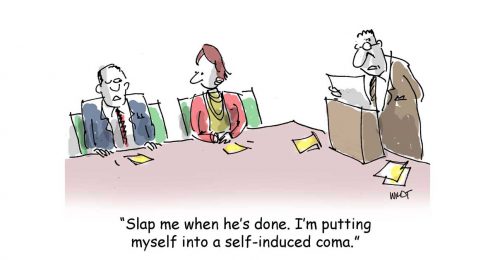It was a very hot summer afternoon. We took our eldest daughter, Scout, to a local circus. She was maybe 3 at the time and had slept the whole ride there. We took this adorable, sweaty, and groggy kid into a really noisy tent, paid for our three tickets, bought some popcorn, and took our seats.
It was so exciting. Well, we were excited — she was dazed and confused.
Until… the first act. Out rolls a cannon. A man climbs in. Another man detonates the pretend wick and BBBBBOOOOOM. The man flies out of the cannon and lands in a net some distance away.
Scout reacted with sheer terror; as if she herself had been ejected from the bleachers. She ran as fast as she could out of the tent, followed by her two mothers. She had been scarred for life by a well-intended afternoon at the circus.
Once she had started breathing again, she asked a single question. And then she asked it again. And again. And again. For the entire ninety-minute ride home.
Her question was simple. “Why’d they shoot dat guy out da cannon?”
And presumably, our answers simply were not cutting it. Answers like, “People think it’s fun,” or “That’s what circus performers do,” fell on deaf ears. These answers offered no solace.
In her quite logical mind, the whole thing seemed unfathomable. Someone suggested to ‘dat guy’ that he get into that cannon so that it could be detonated and ‘dat guy’ could fly through the air into a net that was really far away.
And ‘dat guy’ said YES.
Are you wondering where I am going with this? It’s not a story about what lousy parents we are. It’s a story about ‘dat guy.’ And it’s a story about you.
You are back from some kind of holiday break. Maybe you can barely remember you had one?
You got back to work, you opened your laptop, scanned that January calendar, and before you? An imaginary cannon. And you are ‘dat guy.’
You can agree to begin the year by making an intentional decision to be shot out of a cannon. Endless to-do’s. Everything is a priority. So much noise. Stress. Anxiety.
Or… you can take a different path. Today, I’ll offer you suggestions about three very important conversations you need to have this month.
And I’ll give you one piece of advice before we get started.
Say no to the cannon.
WHY NOW?
Your ability to use January intentionally to get the year off to a good start is key. You will blink and it will be St. Patrick’s Day.
And you’ll need a lot more than the luck of a four-leaf clover to effectively plan a year when you are already three months into it.
So as you look ahead, the forecast is uncertain, but there is indeed buzz about a recession. But when isn’t the forecast uncertain? And when hasn’t the nonprofit sector risen to the occasion? Honestly.
Please worry less about what could go wrong and more about the important work ahead and how to make the case for support.
And as you make that case for support, as you sit here in January and look down the road toward the rest of the year, please have the following conversations before January turns into February.
1. Make Time For An Extended Staff Meeting: Pluses and Deltas
Send a message to your staff (if you are lucky enough to have one). It is vital to breathe and debrief. To talk through what you learned about our organization during the past year.
Here are questions to chew on.
- What strengths did you draw on?
- How was decision-making different?
- Are there examples of ways in which you were nimble this year?
- Did something not meet expectations? Spend extra time on that — be candid and tease out the lessons you learned.
- Many of you had greater impact while being resource constrained. How did you do that?
- If your board stepped up, what did they do? How might you motivate them to keep on that same track?
- You no doubt unearthed cracks in your organization’s foundation. Take ‘em one by one with no judgment. I can already tell you that communications (internal and external) will be on the list. In a crisis, we tend to forget that people really need to know a lot and need to hear from you often.
- End the conversation by going back to talking about new things you tried. If you didn’t try new things, note that and incorporate that mindset into the new year.
2. A Conversation With Your Board Within 45 Days
This is essential. If your organization is to infuse any changes into its DNA, those changes need to be marketed to your board. Far too often boards play the role of ‘risk managers’ and it is so critical for your organization to engage your board in higher-level thinking.
It might even be worthwhile to take a look back at the past few years, including 2020/2021. How is your organization different today than in what I call “the before times” (pre-pandemic)?
A conversation like this presents THE BEST OPPORTUNITY you may have to move your board’s mindset from one that values “oversight” and “managing risk” to one that values impact and innovation.
Now really talk about that with your board. Get out in front of this conversation before someone says the dreaded, “So when do you think we’ll get back to business as usual?” You need to start now to pre-empt that so you don’t have to defend it.
3. A Conversation Led By Your Board Chair About Board Work This Coming Year
If we begin by recognizing that after 2020, none of us will ever be the same, then this would be true for the board of your organization as well.
I propose an executive session with the executive director after conversation #2. The board chair leads a thoughtful conversation that assesses the role of the board, and the lessons learned these past few years and ends with setting some goals about how it will operate differently this year.
Chew on these:
- How did we as a board show up last year? Ask the E.D. for feedback. What are some examples of great partnership? First-rate ambassadorship? What does the E.D. want to see more of?
- What could the board have done more of? What would that look like?
- Get to this conversation: We are so privileged to be on this board — it gives us a sense of meaning in these darkest of days — we should approach board recruitment from this place of abundance and privilege.
- Be sure to tell the E.D. what would help you be great at your job as board members.
- And save the most important thing for last. The board chair or a powerful voice on the board needs to end by talking about strategy, innovation, and adaptability. The E.D. can market it, but the chair has to own it.
The conversations I am suggesting (and I’m sure I heard a few of you saying something about not having time for this) are REFUELING.
THAT is why I am suggesting them. You have just returned from the holidays and hopefully, the break refueled you — put some gas in the tank. But if you climb right into the cannon, your gas gauge will be at “E” in no time flat.
If you make these conversations happen, you will not only look back and remember your heroics, you’ll take the core parts of those heroics and infuse them into how you operate this year.
One last thing. You want to know if you have to get on these conversations right away — you have so many emails. Here’s my advice. Send this blog post to your board chair (or your E.D.). Pick up the phone and talk about it.
I am 100% convinced that these conversations are vital to have and 150% convinced that the longer you wait the less impactful they will be.
You’re back after a break. You can let the work manage you or you can lead with intention. Here’s hoping you pick the latter.
Want to learn from a growing community of nonprofit leaders and get exclusive access to content from a variety of experts? Click here to learn more about the Nonprofit Leadership Lab.



